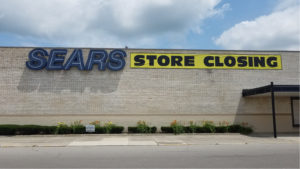The changing retail landscape and the advent of e-commerce have led to radical changes in how and where we shop. Thanks to retail stocks such as Amazon (NASDAQ:AMZN), even previously dominant retailers such as Walmart (NYSE:WMT) had to change the way they did business.
However, some did not adapt with the times and have found themselves struggling. Contrary to popular belief, many of these stores have refused to disappear completely. Some still operate hundreds of stores despite rising debts and falling equity levels. However, with consumers moving on to new retailers with more desirable offerings, the prospects of these retail stocks returning to their former glory appear dim.
Blue Apron (APRN)
Blue Apron (NYSE:APRN) has declined from the get-go. Since debuting in June 2017 at a split-adjusted price of $150 per share, APRN stock has done little else but starve investors.
This happened for two main reasons. One, the public has never really warmed to meal kits. Approximately 23% of the population have tried meal kits and cancelled their subscriptions. As it stands, only 7% subscribe to meal kit delivery services. They have become a pricey alternative, and most will turn to restaurants if they decide to spend on food.
The second, more important reason is the power of its peers. Like many retail stocks, APRN lacks a competitive moat. Any grocery chain, or for that matter, anyone with cooking talent, can start a meal kit service. Blue Apron has learned this the hard way as companies such as HelloFresh, Amazon and Kroger (NYSE:KR) offer competing services.
Moreover, APRN stock continues to suffer revenue declines and massive losses. Analysts forecast that APRN will lose more than $4 per share for each of the next two years. This represents devastation for APRN stock, which trades at barely over $7 per share. Furthermore, it would now sell as a penny stock had it not been for a 1-for-15 reverse stock split. As things stand now, it appears destined to return to penny-stock status.
Destination XL Group (DXLG)
Destination XL Group (NASDAQ:DXLG) operates a chain of apparel stores catering to the big and tall men’s clothing market. Its first store opened in 1976. However, it has operated under several names, Casual Male XL among them. It acquired that name in 2002 by buying the former Casual Male XL.
Unfortunately, Destination XL, like some retail stocks in the apparel business, has teetered on the brink of bankruptcy for years. At its peak, DXLG stock sold for over $25 per share. That happened in 1993.
Though it managed to climb out of penny-stock status during the financial crisis, the DXLG stock price has remained in the single digits since then. DXLG has rarely traded above $3 per share since 2017 and now sells for around $1.25 per share.
It looks like a lucrative business on the surface as Americans gain weight. However, this segment has attracted significant competition. This added pressure has made the company unable to turn a profit in recent years.
Moreover, as of the previous earnings report, the company held just $56.7 million in equity and had accumulated long-term debts amounting to $316.4 million. Unless it can find a way to become profitable quickly, an eventual bankruptcy appears likely.
J. C. Penney (JCP)
One of the twentieth-century retail stocks that has struggled to find its way in the 21st century is J. C. Penney (NYSE:JCP). Poor CEO choices, strategic blunders and struggles to define its reason to exist in the current market have plagued JCP stock.
Today, JCP stock flirts with literal penny-stock status. It trades for around $1.10 per share as of the time of this writing.
To be sure, the financials have become bleak. As of the most recent quarter, the company held $808 million in equity, more than twice its current market capitalization. However, long-term debts top $4 billion. Analyst estimates point to falling revenue and mounting losses.
It did not have to turn out this way. In 2007, JCP stock traded as high as $87 per share. Like most every retail stock, it took a hit during the financial crisis. However, after that time, the demise came mostly from self-inflicted wounds. In 2010, it brought in Apple (NASDAQ:AAPL) retail head Ron Johnson. Johnson eliminated private label brands and coupons, which alienated many of its core customers. Though he lasted only 17 months on the job, the damage had been done. Without the funding to recover, J. C. Penney went into permanent decline.
The retailer still runs about 865 stores. However, with no funding available to revamp itself and no clear place in today’s retail environment, it remains unclear how JCP stock can recover.
Rite Aid (RAD)
Rite Aid (NYSE:RAD) is among the retail stocks that has refused to die despite its best attempts. Repeated tries at selling itself to competitors led only to a sale of some of its stores to Walgreens (NASDAQ:WBA). However, it has consistently lagged its main peers, Walgreens and CVS Health (NYSE:CVS), for many years.
Now with Amazon entering the pharmacy business, one has to wonder if Rite Aid has a reason to exist. CVS felt it had to enter the insurance business to ensure its survival. RAD stock has no such luxury. It has suffered as mounting losses and a crushing debt load limit its options. Rite Aid holds over $3.8 billion in debt against only about $960 million in equity. Although analysts predict 5 cents per share in earnings this year, they forecast a 29 cent per-share loss next year.
For now, Rite Aid stock sells for around $7.90 per share. However, only a 1-for-20 reverse stock split kept it out of penny-stock status. The reverse split may only offer the company a short reprieve. Still, due to its troubled balance sheet, one has to wonder how it will keep its doors open amid the losses. With competition intensifying and no room to pivot, I see little hope for the future of RAD stock.
RTW Retailwinds (RTW)
Consumers and investors may know RTW Retailwinds (NYSE:RTW) better by the name of some of its stores, New York & Company. The women’s clothing retailer began in 1918 as Lerner Shops. It has undergone several name changes. The latest occurred in 2018 when it relaunched as RTW Retailwinds to reflect a multi-brand platform.
Several retail stocks have undergone such a strategic pivot before. Some have succeeded better than others. It has not seemed to help RTW as competition remains an ongoing concern in this industry. Now, it looks like its peers have the upper hand.
Since the name change in September 2018, RTW stock has lost about 80% of its value. It sells for about 90 cents per share as of the time of this writing.
In its most recent quarterly report, it announced a 5% sales decline and revealed plans to close 27 of its 414 store locations. Even with lower revenues, it saw a 55% increase in its Fashion to Figure plus-size brand. Still, that bright spot failed to compensate for the sales decline.
Moreover, its financials resemble that of other retailers. It holds about $67.8 million in equity versus a debt load of $247.6 million. Considering the financials and falling sales, the odds of bankruptcy seem only to increase.
Sears (SHLDQ)

Not surprisingly, the most dramatic fall from grace among retail stocks belongs to Sears (OTCMKTS:SHLDQ). Sears spent most of the 20th century as America’s largest retailer. In the late 1970s, Sears accounted for about 1% of America’s GDP.
However, plans to revitalize the store at that time started Sears down the path of decline. One of the more notable strategic blunders came in 1993 when Sears ended its catalog business. One year later, Jeff Bezos founded Amazon on what would become the 21st century-version of catalog selling, e-commerce.
As if destroying itself were not enough, it took down the former No. 2 retailer with it. In 2004, Sears Holdings bought Kmart. However, this marriage became more like a suicide pact as the decline continued and stores closed. In the end, it would sell off iconic brands such as Kenmore and Craftsmen. Even this did not stop the firm from declaring bankruptcy in 2018.
Sears is not dead, at least not yet. A bankruptcy judge approved the sale of its assets to former CEO Eddie Lampert. SHLDQ stock now trades on the pink sheets and sells for around 20 cents per share as of the time of this writing.
The reorganization in bankruptcy appears unlikely to succeed. By February, analysts expect only 128 stores to operate. Plans to open small, appliance-centered stores have led to only three store openings. As suppliers cut off shipments and shelves remain sparse, most analysts give it little chance of survival.
Tuesday Morning (TUES)

Tuesday Morning (NASDAQ:TUES) stock has become another story of decline among retail stocks. At its peak in 2005, it sold for over $35 per share. Even as recently as 2014, TUES stock traded at $22 per share.
However, several management missteps sent the equity into decline. Tuesday Morning lagged its peers on the e-commerce front. Moreover, it underperformed competitors on operations and failed to define its target market. As a result, growing debts and continuing losses have undermined investor confidence in TUES stock.
Now, company financials reflect that of other struggling retail stocks. The $440 million in debt spells trouble for a company with about $160 million in equity. Moreover, it has posted annual losses for years.
TUES stock bulls had pinned hope on efforts to optimize the supply chain, bringing costs to a point where the company could turn a profit. Tuesday Morning still operates more than 700 stores across the country. Since it now trades at around $1.80 per share, a successful turnaround could bring massive gains to TUES stock investors. However, with losses projected for the foreseeable future, few signs of recovery have appeared. Hence, it may ultimately take a bankruptcy for this seller of closeout merchandise to avert its own closeout.
As of this writing, Will Healy did not hold a position in any of the aforementioned stocks. You can follow Will on Twitter at @HealyWriting.





